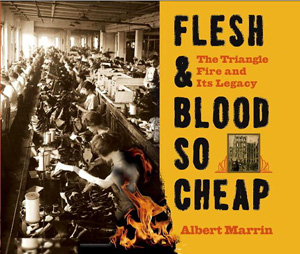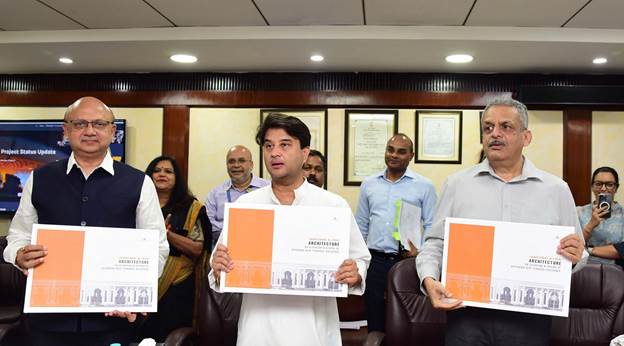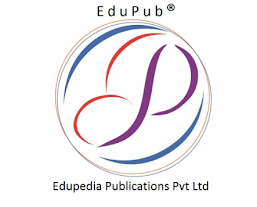Post Page Advertisement [Top]
Mysteries of the Wilderness
Book Review: Flesh & Blood So Cheap

I liked this book. People who are interested in national disasters and US history as well as immigration will most probably be interested in reading this book.
Readers can gain knowledge of what it was like to work in New York City in the early 1900s. One of the things that was especially interesting was that there were no safety laws at work. Also, there was a big contrast between the rich and the poor. Some people may not like this book because it is very depressing, but it is an important event in history to remember.
This book was very well written. It has black and white photos along with descriptions of the photos. These photos give us a better idea of what people's lives were like. This book is suitable for 9-20 year olds.
I give this book 5 stars.
Recent Researches in Biotechnology
Recent Researches in Biotechnology
The Heaven & Earth Grocery Store: A Novel Kindle Edition by James McBride
Product details
- ASIN : B0BPNP7YQB
- Publisher : Riverhead Books (August 8, 2023)
- Publication date : August 8, 2023
- Language : English
- File size : 1898 KB
- Text-to-Speech : Enabled
- Screen Reader : Supported
- Enhanced typesetting : Enabled
- X-Ray : Enabled
- Word Wise : Enabled
- Sticky notes : On Kindle Scribe
- Print length : 400 pages
- Page numbers source ISBN : 1399620401
- Customer Reviews:
About the author

James McBride is the author of the award-winning New York Times bestseller, The Color of Water. A former reporter for The Washington Post and People magazine, McBride holds a Masters degree in journalism from Columbia University and a B.A. from Oberlin College.
Book on AAI Airports' Terminal Building Architecture
The Minister of Civil Aviation & Steel, Shri Jyotiraditya M. Scindia released a coffee table book on traditional and local architecture of various terminal buildings at AAI airports in New Delhi today. The book highlights the facade of terminal buildings at 19 airports. This publication is a remarkable endeavour that portrays the upcoming Airport Terminal buildings in the light of traditional values.
The future terminals will ingeniously blend Indian architectural excellence with practicality, effectively conveying the essence of our heritage.

The airport terminal building orchestrates the seamless transition between aircraft and ground transportation, serving as a conduit for the various services associated with air travel. A terminal becomes a gateway that shapes visitors' initial impressions of a city. They are no longer just simple structures of convenience and have to be seen as landmarks of the city, as marvels, which welcome visitors to the city and inspire a feeling of awe and wonder in travellers.

The Prime Minister Shri Narendra Modi has a vision to showcase the heritage of India’s rich social and cultural diversity and he has played a significant role through his ardent efforts in promoting the cultural heritage of India and putting it on the global map. Following his footsteps, Minister of Civil Aviation, Shri Jyotiraditya M. Scindia envisaged to combine Indian architectural brilliance with functional ease in existing and upcoming terminal buildings to convey the essence of Indian heritage to each passenger or passer-by. These terminal buildings are imbued with a sense of heritage, making them not just memorable structures but also symbolic expressions of the nation's identity.
Under his guidance, Airports Authority of India has tried to create Airport Terminals to be remembered as memorable and an iconic addition to the city-scape. The Terminal buildings stand not merely as physical entities but as embodiments of an idea that reflects the mosaic of India's culture, tradition, and art. These terminals are poised to be emblematic of local communities' pride and a source of national inspiration.

Shri Rajiv Bansal, secretary, Ministry of Civil Aviation, Shri Chanchal Kumar, OSD, Ministry of Civil Aviation, Shri Zulfiquar Hasan, DG, BCAS, Shri Vikram Dev Dutt, DGCA, Shri Sanjeev Kumar, Chairman, AAI among others were present at the event.
***
The Infographic Guide to Personal Finance: A Visual Reference for Everything You Need to Know
Book Review: If I Never Forever Endeavor

This book was about a bird who didn't yet know how to fly.
The bird has to decide if it will try to fly, but it was not sure if it wants to. The bird thought, "If I never forever endeavor" then I won't ever learn. On one wing, he worries he might fail and on the other wing he thinks of how he may succeed. He worries that if he tries, he may get lost in the world. That makes him want to stay in his nest where he's safe.
I think this book would help other children to learn that trying new things can be scary, but sometimes when we try, we can find things that make us happy too. And this book will help others know that mistakes are okay and part of learning.
My favorite part is that the bird tried and learned that she could fly. I also liked that I read this book because it gave me a chance to talk to mom about making mistakes and how I don't like making them. Then I learned they are good and part of learning.
Boys and girls who are 3 to 8 years old would like this book because it teaches about trying a new thing and how it's important to get past being scared so you can learn new things.
I give the book 5 stars since I think it's important for other children to learn about courage.
Review of Book - Atomic Habits
THE PHENOMENAL INTERNATIONAL BESTSELLER: OVER 1O MILLION COPIES SOLD WORLDWIDE
Transform your life with tiny changes in behaviour, starting now.
People think that when you want to change your life, you need to think big. But world-renowned habits expert James Clear has discovered another way. He knows that real change comes from the compound effect of hundreds of small decisions: doing two push-ups a day, waking up five minutes early, or holding a single short phone call.
He calls them atomic habits.
In this ground-breaking book, Clears reveals exactly how these minuscule changes can grow into such life-altering outcomes. He uncovers a handful of simple life hacks (the forgotten art of Habit Stacking, the unexpected power of the Two Minute Rule, or the trick to entering the Goldilocks Zone), and delves into cutting-edge psychology and neuroscience to explain why they matter. Along the way, he tells inspiring stories of Olympic gold medalists, leading CEOs, and distinguished scientists who have used the science of tiny habits to stay productive, motivated, and happy.
These small changes will have a revolutionary effect on your career, your relationships, and your life.
________________________________
A NEW YORK TIMES AND SUNDAY TIMES BESTSELLER
'A supremely practical and useful book.' Mark Manson, author of The Subtle Art of Not Giving A F*ck
'James Clear has spent years honing the art and studying the science of habits. This engaging, hands-on book is the guide you need to break bad routines and make good ones.' Adam Grant, author of Originals
'Atomic Habits is a step-by-step manual for changing routines.' Books of the Month, Financial Times
'A special book that will change how you approach your day and live your life.' Ryan Holiday, author of The Obstacle is the Way
- Publisher : Random House Business (30 October 2018)
- Language : English
- Paperback : 320 pages
- ISBN-10 : 1847941834
- ISBN-13 : 978-1847941831
- Reading age : Customer suggested age: 13 years and up
- Item Weight : 390 g
- Dimensions : 15.3 x 2.4 x 23.4 cm
- Country of Origin : United Kingdom
Book Review
SUMMARY
[Introduction] James starts by sharing personal strategies he implemented to recover from a serious accident in high school. That event forced him to improve the quality of his routine to get his life in order, coming to the conclusion that “we all deal with setbacks, but in the long run, the quality of our lives often depends on the quality of our habits. With the same habits, you will end up with the same results. But with better habits, anything is possible.”
[Section I : The Fundamentals]
[Chapter 1] Here we learn the power of compounding effect: changes that seem small and unimportant at any given day will compound into remarkable results if we are willing to stick with them for months and years. James explains that “breakthrough moments are often the result of many previous actions, which build up the potential required to unleash a major change.” Comparing to habits, he shows that bamboo can barely be seen during the first couple of years while the roots grow underground before exploding for almost 100 feet into the air in a few weeks. From that perspective, we come to understand the best outcomes are generally delayed.
[Chapter 2] Based on a 3-layer concentric circle behavior change model—divided into outcome change, process change, and identity change—James explains that we should pay attention to our inner identity by focusing on beliefs, assumptions, and values. “Many people begin the process of changing their habits by focusing on what they want to achieve. This leads us to outcome-based habits. The alternative is to build identity-based habits. With this approach, we start by focusing on who we wish to become.” The strongest changes, then, happen from inside out, starting from our identity, passing through the process, and ultimately changing the outcome.
[Chapter 3] In this chapter we are introduced to a 4-step framework, which is composed of cue, craving, response, and reward. James calls it 'The 4 Laws of Behavior Change'. He then explains that we can think of each law as a lever that influences our behavior—when the levers are in the right positions, they create good habits effortless whereas when they are in the wrong position, it is nearly impossible. Through examples, he explains that “the cue triggers a craving, which motivates a response, which provides a reward, which satisfies the craving and, ultimately, becomes associated with the cue.” Together they create a habit loop that, when repeated many times, habits become automatic.
[Section II : Make It Obvious]
[Chapter 4] A primer on how cues play a crucial role in predicting habit formation without consciously thinking about the outcomes. Once our habits become so common, the cues associated with them become essentially invisible because they are deeply encoded. If we want to create better habits, a good idea is to be aware of the cues. James finishes up by sharing a strategy called 'Habits Scorecard'—a simple exercise to become more aware of our behavior on a daily basis. We first write down a chronological list of our daily habits and, once we have a full list, we score each habit as an effective, ineffective, or neutral habit. Besides noticing what is actually going on, we can notice if certain behaviors help us become the type of person we wish to be.
[Chapter 5] The cues that can trigger a habit come in a wide range of forms, and the 2 most common cues are time and location. When we make a specific plan for when and where we will perform a new habit, we are more likely to follow through. Stacking our habits by pairing a new habit with a current habit is a form to connect our behavior to our own advantage. An example when building a daily journaling habit would be: “after I pour my cup of coffee each morning, I will journal for 5 minutes.”
[Chapter 6] This chapter shows how our environment plays a crucial role in defining habit behaviors. “Given that we are more dependent on vision than any other sense, it should come as no surprise that visual cues are the greatest catalyst of our behavior.” To build good habits, then, we should either make desirable cues obvious in our environment or build new habits in a new environment to avoid fighting against old ones.
[Chapter 7] One of the most practical ways to break a bad habit is to reduce exposure to the cue that causes it. As James points out, “it is easier to avoid temptation than resist it.”
[Section III : Make It Attractive]
[Chapter 8] James explains how the modern food industry has created products that are more attractive and addictive to consumers, and by doing so he shows that the more attractive an opportunity is, the more likely it is to become habit-forming. Every behavior that is highly habit-forming tends to be associated with higher levels of dopamine. It is the anticipation of a reward that motivates us to take action. “Temptation bundling is one way to make your habits more attractive. The strategy is to pair an action you want to do with an action you need to do.”
[Chapter 9] “We tend to adopt habits that are praised and approved of by our culture because we have a strong desire to fit in and belong to the tribe.” That said, it is common to pick up habits and behaviors from our parents, peers, and colleagues. There is also a tremendous internal pressure to comply with the norms of the tribe. And, finally, we try to copy the behavior of successful people because we desire success ourselves. One of the best strategies to build better habits is to join a culture where the desired behavior is the normal behavior.
[Chapter 10] To avoid unnecessary and detrimental cravings, we should highlight the benefits of avoiding a bad habit by making it seem unattractive. “Habits are unattractive when we associate them with negative feelings.”
[Section IV : Make It Easy]
[Chapter 11] “All habits follow a similar trajectory from effortful practice to automatic behavior, a process known as automaticity. Automaticity is the ability to perform a behavior without thinking about each step, which occurs when the nonconscious mind takes over.” The key component is to pay close attention to the frequency we perform a habit, not much for how long we have been practicing it.
[Chapter 12] Since every action requires a certain amount of energy, we are motivated to do what is easy. By contrast, the more energy required, the less likely it is to occur. “You don't actually want the habit itself. What you really want is the outcome the habit delivers. The greater the obstacle, the more friction there is between you and your desired end state.” That is why we should reduce the friction associated with our habits by creating a prosperous environment to make future actions easier.
[Chapter 13] There are decisive moments that deliver an outsized impact every single day. As James puts, these decisive moments are a fork in the road, sending us in the direction of a productive path or an unproductive one. To avoid procrastination, the skill of 'Showing Up' says that we should start a new habit by taking baby steps, making it as easy as possible to take action. “A new habit should not feel like a challenge. The actions that follow can be challenging, but the first 2 minutes should be easy. What you want is a gateway habit that naturally leads you down a more productive path.” He calls it the 'Two-Minute Rule', meaning that new habits should take less than 2 minutes to do in the beginning. Once the habit is established we can improve and master the finer details.
[Chapter 14] In order to keep bad habits away is to make them difficult in the first place. There are 2 interesting strategies to improve our future behavior. [1] Make good choices in advance before we can fall victim to temptation in the future. James gives a personal example by sharing that whenever he is looking to cut calories he will ask the waiter to split his meal and box half of it to go before the meal is served. If, however, he waits for the meal to be served and tries to eat just half, that would never happen. [2] Make onetime actions that can automate our future habits and deliver increasing returns over time such as buying a good water filter, unsubscribing from unwanted emails, moving to a friendlier neighborhood, buying a standing desk, or setting up automatic bill pay.
[Section V : Make It Satisfying]
[Chapter 15] We should make sure to feel immediately satisfied after performing a new habit to increase the odds that the behavior will be repeated next time. “The human brain has evolved to prioritize immediate rewards over delayed rewards.” For that, we can add a little bit of immediate pleasure to the habits that pay off in the long-run.
[Chapter 16] Here we learn how to measure our progress by tracking our habits. The immediate satisfaction it delivers—as mentioned earlier in Chapter 15—is one of the many benefits that standout. Besides that, James says, “when we get a signal that we are moving forward, we become more motivated to continue down that path.” The most basic format to track our habits is to get a calendar and mark an X each time we stick with our routine. One of the most important passages of the entire book is as follows: “If you miss one day, try to get back into it as quickly as possible. The first mistake is never the one that ruins you. It is the spiral of repeated mistakes that follows. Missing once is an accident. Missing twice is the start of a new habit. This is a distinguishing feature between winners and losers. Anyone can have a bad performance, a bad workout, or a bad day at work. But when successful people fail, they rebound quickly.”
[Chapter 17] In order to prevent bad habits and/or eliminate unhealthy behaviors, James says that we could either add an instant cost to the action or make it painful. A habit contract is also another strategy to hold our accountability: “It is a verbal or written agreement in which you state your commitment to a particular habit and the punishment that will occur if you don't follow through. Then you find one to two people to act as your accountability partners and sign off on the contract with you.”
[Section VI : Advanced Techniques]
[Chapter 18] We learn how to distinguish habits when genes may or may not influence our performance especially for competitive activities. “One of the best ways to ensure your habits remain satisfying over the long-run is to pick behaviors that align with your personality and skills.” James proposes us to set some time apart to explore new activities in the beginning, before shifting our focus to exploit them thoroughly.
[Chapter 19] When we find the sweet spot of our ability we tend to learn best and fastest. The ‘Goldilocks Rule’ states that "humans experience peak motivation when working on tasks that are right on the edge of their current abilities. Not too hard. Not too easy. Just right.”
[Chapter 20] One downside of certain habits, James explains, is that we may stop paying attention to the little details and errors. To counterbalance that we should review and reflect on the process over time to remain conscious of our own performance. Using a simple chart to convey his message, we learn that “the process of mastery requires that you progressively layer improvements on top of one another, each habit building upon the last until a new level of performance has been reached and a higher range of skills has been internalized.”
PERSONAL THOUGHTS
Reading the book twice helped me take better notes and capture details. In the meantime, I thought about 3 simple strategies that could improve our adherence to new habits. Let me share these strategies here with you, and in the following section, I will describe how I managed to cultivate the first 3 new habits upon reading the book—following the system proposed by James together with these 3 strategies.
[1] The first strategy is about determining a 'commitment time frame' to avoid excuses during this initial trial period. A 1-month time frame is a fair commitment, choosing to start on the first day of the month to practice it every single day for a full month. Just at the end of the period, I will take the time to reflect and evaluate the pros and cons.
[2] The next one is to choose only 1 new habit each month. In doing so we become familiar with the practice intentionally while we develop a sense of purpose.
[3] Last, during the first month of any new habit, I noticed that if I spend time exploring the details and the benefits, my motivation stays high. It doesn't only help us create better practices, but it is also inspiring to learn from others who have succeeded previously by adding the same habit into their lives. Podcasts, articles, videos, books, online courses, tutorials, and blog posts are all good sources.
IMPLEMENTATION OF NEW HABITS
[Nov 1, 2018] I had been wanting to journal on a daily basis for many years but that had never happened. Although I have carried a notebook with me for quite a while, it has never worked as a real journal—a daily routine, when we sit down and write personal thoughts, intentions, and reflections at around the same time. Instead, it has been mostly used to take notes during meetings, to write down ideas and thoughts, to express travel memories, and to doodle. Today, after 3+ months, I haven't looked back once, and still can't believe it took me that long to start this daily habit. During the first month, I read blog posts, watched videos, and even read a short and inexpensive book to foster my creativity.
[Dec 1, 2018] I have been impressed by the physical capabilities we can develop through body movement. Although yoga has been a special part of my life since I was 18, I hadn't given proper attention to handstands. But now, after 2+ months practicing it every day, it is rewarding to see improvements on a weekly basis. Again, I definitely recommend watching videos and reading tutorials to find your favorite method. This is the perfect habit to stack at the end or in the middle of any physical movement practice you may enjoy.
[Jan 1, 2019] By now we know the benefits of cold showers—ranging from healthier skin appearance all the way to a more resilient perspective of the world. I had previously taken cold showers for 3 months in 2017, but it was a “goal” mindset instead of a “habit” mindset. After that trial I set aside and, although I have kept taking cold showers once or twice a week since then, I wished cold showers was the default mode. Now, after 1+ month, I can't see myself taking warm showers. After all, it is about intention. Again, we can learn uncountable benefits of cold showers by reading success stories. One of my inspirations was Wim Hof. It isn't comfortable in the beginning of any chosen day, but after 3-4 minutes, both my breath and thoughts calm down.
Putting them together, these 3 habits don't take more than 30 minutes of my day. While I spend about 10 minutes journaling and 10 more minutes practicing handstands, I save 5 minutes taking cold showers because I won't stay any longer than necessary.
RECOMMENDATION
[1] First, if you have watched videos, listened to podcasts, read articles and books on habit formation and, after all that, you feel satisfied, then, please, save your money and time.
[2] However, if you are like me, that even after reading a few books on building habits and having successfully added good habits to your life, feel that there is still room for improvement, this book can be a terrific addition.
[3] Last, if you haven't spent much time and energy discovering a good system to build lasting habits while breaking bad ones, please, read this book.
COMPLEMENTARY READINGS
[1] Game Changers, by Dave Asprey, exposed me to a wealth array of ideas/habits/tools that have helped me decide which new habit to build next. The book is divided into 46 laws.
[2] Essentialism, by Greg McKeown, helped me focus on less but more important tasks, giving clarity to what matters most. This is especially interesting to break bad habits.
[3] The Talent Code, by Daniel Coyle, brought more motivation when learning new skills based on the assumptions that we develop new talents through deep practices, finding our ignition identity, and having the right coach to guide us genuinely. I read it many years ago, then, a few years back, I read his following book called The Little Book of Talent—which is perhaps even more to the point.
[4] The Systems View of Life, by Fritjof Capra, enlightened my perspectives on how nature and living beings are systematically integrated. It is a profound and slightly academic book that can complement Atomic Habits especially to tie together the 4-step framework into the feedback loop system.
I sincerely hope you, too, have fun while building new habits.
Latest Posts
Search for More
Categories
Most Popular

Benefits of Writing Book Reviews
Special Book Publication Offer: Publish Your eBook for Just $50 with EduPub
Publication
Publication Services







Get your edited books and book chapters published through EDUpub. Send the manuscript to editor@pen2print.org Edupedia Publications Pvt Ltd - Education Publisher
Contact form

Indexing of Educaitonal Contents for the Scholars and Researchers.
Join us on Youtube
News and Updates
.jpg) Publisher
Publisher
Call for Book Publication – Edupedia Publications: Submit Your Manuscript Now!
Edupedia Publications, a renowned name in academic and professional publishing, is no…
Find and Read Interesting Articles
Recent Articles
Read more articles from authors around the world.
Contact Form
Brand Promotion
Header Ads Widget
Published Books
Payment Options
Total Readers of Today
Books
Edited Books
Popular Books
-
Writing book reviews offers numerous benefits, including: 1. *Improved critical thinking and analysis*: Evaluating books helps d...
-
Edupedia Publications, a renowned name in academic and professional publishing, is now calling for book submissions from authors, research...
-
EduPub is excited to present an exclusive offer for authors! For a limited time, you can publish your eBook for only $50 . Whether you'r...
New Books
News

EDUpub help scholars in getting research papers, book, book chapters and conference proceedings get published. Send manuscript for review to editor@edupub.org





















.jpg)
